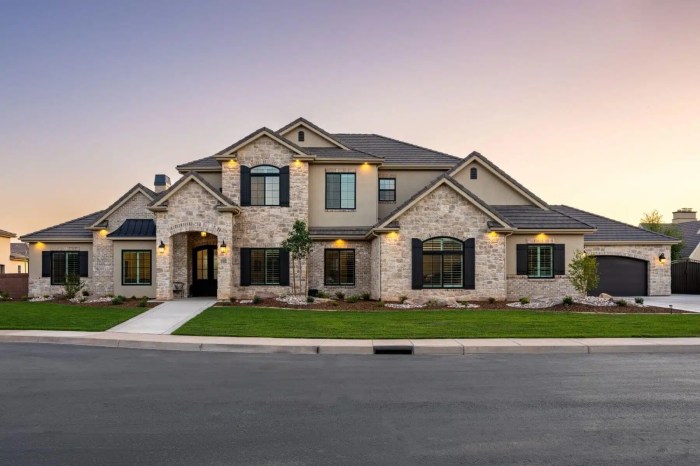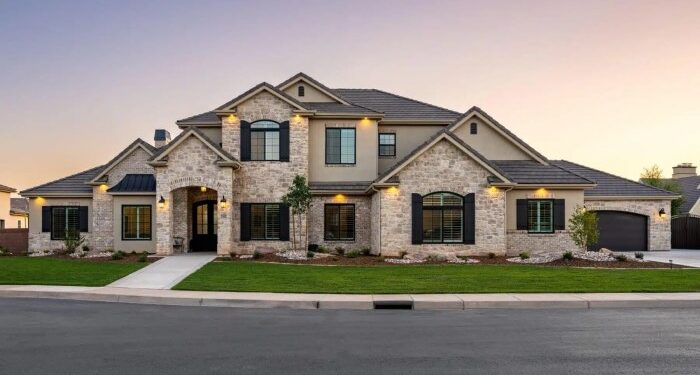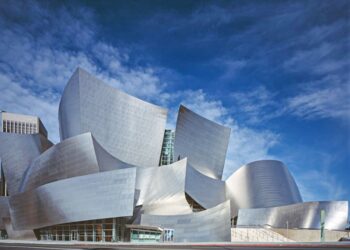Embark on a journey through the world of custom home exteriors, where every detail is tailored to perfection. From unique design elements to sustainable practices, discover how customizing your home's exterior can elevate its appeal and reflect your personal style effortlessly.
Learn about the latest trends and budgeting tips to help you create the exterior of your dreams without breaking the bank. Dive in and let your home's exterior make a statement that truly speaks to who you are.
Importance of Custom Home Exteriors
Customizing home exteriors plays a crucial role in creating a unique and personalized living space that reflects the homeowner's individuality and taste. It goes beyond just aesthetics, impacting the overall look and feel of a property.
Enhancing Curb Appeal
Custom exteriors significantly enhance the curb appeal of a home, making it stand out from the neighboring properties. By incorporating personalized design elements, colors, and materials, the exterior of a home can create a lasting impression on visitors and passersby.
Reflecting Personal Style
Custom home exteriors offer homeowners the opportunity to showcase their personal style and preferences. Whether it's a modern, traditional, minimalist, or eclectic design, customizing the exterior allows individuals to express themselves through their living space. This not only adds character to the property but also creates a sense of pride and ownership.
Design Elements for Custom Home Exteriors
When it comes to designing custom home exteriors, there are several key elements to consider that can greatly impact the overall look and feel of the property. From materials to colors and textures, each component plays a crucial role in creating a cohesive and visually appealing exterior design.
Materials Selection
Choosing the right materials for your custom home exterior is essential in achieving the desired aesthetic and functionality. Siding, roofing, and trim are three primary components where material selection can make a significant difference.
- Siding: Options such as vinyl, wood, fiber cement, or metal siding can drastically change the appearance of your home. Each material offers different textures, colors, and durability levels to suit your preferences and budget.
- Roofing: From asphalt shingles to metal roofing, the material you choose for your roof can impact the overall style and maintenance of your home. Consider factors like longevity, energy efficiency, and architectural compatibility when selecting roofing materials.
- Trim: Trim details like window casings, door frames, and decorative accents can add character and charm to your custom home exterior. Materials like wood, PVC, or composite trim can provide both aesthetic appeal and protection against the elements.
Colors and Textures
The use of colors and textures in custom home exteriors can transform the look of a property and create a unique visual identity.
- Colors: The color palette you choose for your exterior can evoke different moods and styles. Neutral tones like whites, grays, and beiges can create a timeless and elegant look, while bold colors like blues, greens, or reds can make a statement and add personality to your home.
- Textures: Incorporating textures like stone veneer, brick accents, or wood siding can add depth and visual interest to your custom home exterior. Mixing different textures can create a dynamic and layered appearance that enhances the overall design.
Trends in Custom Home Exteriors
Custom home exteriors have seen a shift in trends over the years, with homeowners looking for innovative and unique designs to make their homes stand out. Let's explore some of the current trends in custom home exteriors.
Traditional vs. Modern Exterior Design Trends
When it comes to custom home exteriors, there is a noticeable contrast between traditional and modern design trends. Traditional exteriors often feature classic architectural elements such as pitched roofs, brick or stone cladding, and decorative trim. On the other hand, modern exteriors tend to incorporate sleek lines, large windows, and a focus on minimalism.
- Traditional Exterior Styles:
- Colonial: Characterized by symmetrical design, columns, and gable roofs.
- Craftsman: Known for exposed rafters, front porches, and natural materials.
- Tudor: Features steeply pitched roofs, decorative half-timbering, and arched doorways.
- Modern Exterior Styles:
- Contemporary: Emphasizes clean lines, large windows, and a mix of materials.
- Mid-Century Modern: Incorporates flat roofs, open floor plans, and geometric shapes.
- Minimalist: Focuses on simplicity, neutral colors, and a lack of ornamental details.
Sustainable Practices in Custom Exterior Design
When it comes to custom home exteriors, incorporating sustainable practices is not only environmentally friendly but also cost-effective in the long run. By choosing eco-friendly materials and technologies, as well as focusing on energy efficiency, homeowners can create beautiful exteriors that have a positive impact on the environment.
Incorporating Sustainable Practices
One way to incorporate sustainable practices into custom exteriors is by using recycled or reclaimed materials. These materials not only reduce waste but also add a unique touch to the design. Additionally, choosing materials that are locally sourced can help reduce the carbon footprint associated with transportation.
Eco-friendly Materials and Technologies
- Utilizing solar panels on the roof or walls to harness renewable energy.
- Installing energy-efficient windows and doors to reduce heat loss and gain.
- Opting for low-VOC paints and finishes to improve indoor air quality.
Importance of Energy Efficiency
Energy efficiency is crucial in exterior design as it not only reduces utility bills but also minimizes the overall environmental impact of the home. By properly insulating the exterior walls and using energy-efficient appliances, homeowners can significantly decrease their energy consumption and carbon footprint.
Budgeting for Custom Exterior Design
When embarking on a custom exterior design project, budgeting plays a crucial role in ensuring the success of the endeavor. By carefully planning and managing your finances, you can achieve a personalized look for your home without breaking the bank.
Tips for Budgeting a Custom Exterior Design Project
Before diving into the design process, consider these tips to effectively budget for your custom exterior design project:
- Set a realistic budget based on your financial capabilities and desired outcomes.
- Research the costs of materials, labor, and other expenses involved in the project.
- Consult with professionals to get accurate estimates and avoid unexpected costs.
- Prioritize essential elements of the design to allocate your budget effectively.
- Include a contingency fund for unforeseen expenses or design changes.
Cost-Effective Ways to Achieve a Custom Look
Creating a custom look for your home doesn't have to be expensive. Consider these cost-effective ways to achieve a personalized exterior design:
- Focus on enhancing key architectural features of your home rather than costly additions.
- Opt for durable and low-maintenance materials to reduce long-term maintenance costs.
- Explore DIY options for minor improvements or decorations to save on labor costs.
- Repurpose existing materials or furnishings creatively to add a unique touch to your exterior.
Strategies for Prioritizing Expenses in Exterior Design
When working with a limited budget, it's essential to prioritize expenses wisely to make the most of your resources. Consider the following strategies for prioritizing expenses in exterior design:
- Invest in high-quality materials for elements that have a significant impact on the overall look of your home, such as the front door or windows.
- Allocate more budget to areas that add value to your property, such as landscaping or outdoor lighting.
- Consider phased implementation of the design to spread out costs over time and avoid financial strain.
- Consult with a designer or architect to identify cost-effective alternatives without compromising the design quality.
Wrap-Up

As we conclude our exploration of custom home exteriors, it's clear that the possibilities are endless when it comes to transforming your property. By embracing custom design elements, incorporating sustainable practices, and budgeting wisely, you can create a home exterior that not only impresses but also stands the test of time.
Let your imagination run wild and watch as your custom home exterior becomes a true reflection of your unique taste and personality.
Q&A
How can custom home exteriors enhance curb appeal?
Custom home exteriors can enhance curb appeal by adding unique design elements, personalized touches, and high-quality materials that make your property stand out from the rest.
What are some cost-effective ways to achieve a custom look for home exteriors?
One cost-effective way to achieve a custom look for home exteriors is by focusing on key design elements like color schemes, textures, and architectural details that can make a big impact without breaking the bank.
How important is energy efficiency in custom exterior design?
Energy efficiency is crucial in custom exterior design as it not only helps reduce environmental impact but also lowers utility costs in the long run. By incorporating eco-friendly materials and technologies, you can create a sustainable and efficient home exterior.






